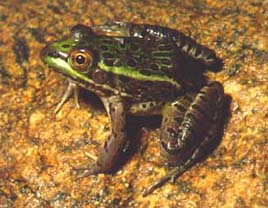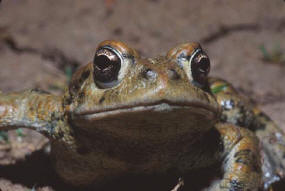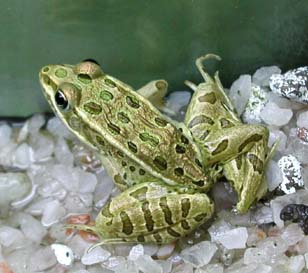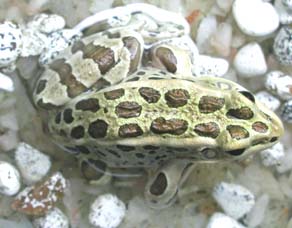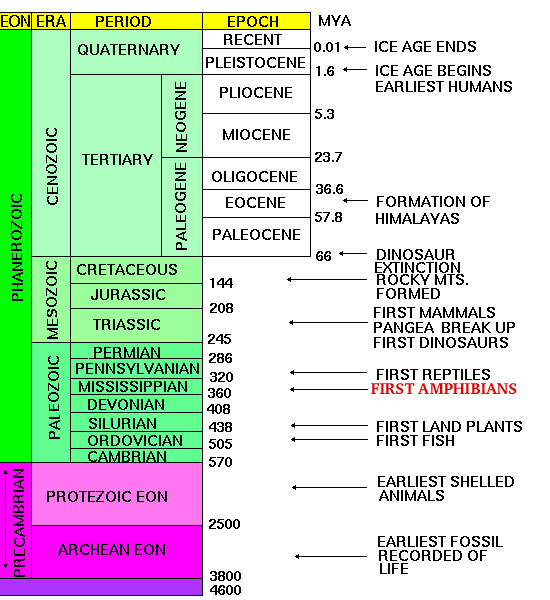|
Amphibian Declines |
|
|---|---|
|
Natural extinctions and population fluctuations are a normal part of nature. Scientists have uncovered five mass extinctions throughout the history of earth. But the accelerated rate at which many species are now declining and disappearing is very alarming to the scientific community. It is believed we are now in the sixth mass extinction event; the first ever caused by the actions of a single species, humankind. During the past couple decades, scientists have become concerned that many of our amphibian populations are declining and some species have become extinct in areas of the world that are relatively undisturbed by man. Below are but a few examples of the many declines and extinctions of the past two decades: The golden toad (Bufo periglenes) was first discovered in the remote and pristine cloud forests of the Monteverde Preserve of Costa Rica in 1967. This toad was very unusual because it was sexually dimorphic (the sexes could easily be identified.) The last golden toad ever seen was in 1987 and they have now been declared extinct.
|
|
|
The northern gastric brooding frog (Rheobatrachus vitellinus) of Australia was discovered in 1984 and last seen in the wild in 1985 following the fate of the closely related gastric brooding frog (Rheobatrachus silus) that was discovered in Australia in 1973 and had disappeared by 1981. These unusual frogs brooded their young in their stomachs and were of interest to the scientific and medical community as they ceased producing hydrochloric acid in the stomach when they were brooding young frogs. In the United States, populations of the western toad (Bufo boreas) and Chiricahua leopard frog (Rana chiricahuensis) have plummeted by 80%, the mountain yellow-legged frog (Rana mucosa) has disappeared from much of its range, and recent surveys to find the Yosemite toad (Bufo canoris) in Yosemite National Park were fruitless. Two species, the relic leopard frog (Rana onca) and the Wyoming toad (Bufo baxteri) are on the brink of becoming extinct in the wild and the Vegas Valley leopard frog (Rana fisheri), last seen in 1942, is now extinct.
|
|
|
Photo by Cecil Schwalbe, USGS Chiricahua Leopard Frog Rana chiricahuensis |
Photo by Joyce Gross Western Toad Bufo boreas
|
|
Population declines and extinctions are not the only problems facing amphibians today. Scientists have noted an increase in reports of malformations. Scientists believe there are three main factors contributing to the increase in malformations: increases in UV-B radiation because of the thinning ozone layer, chemical pollution (insecticides and pesticides), and parasites (chytrid fungus). These factors combined with a weakened immune system due to environmental stressors, can increase the number of malformations found in a population. Malformations come in many forms ranging from missing limbs, bones and eyes, to extra limbs, digits and eyes. Few, if any, of these malformed amphibians survive to reproduce. Tennessee does not appear to have an abnormal number of malformations, but we need to be watchful. For more information about malformations, including state maps showing reported malformations, visit the web site for the North American Reporting Center for Amphibian Malformations.
|
|
|
Photo by the Minnesota Pollution Control Agency Northern Leopard Frog (Rana pipiens) Notice the right fused extra hind limb.
|
Photo by the Minnesota Pollution Control Agency Northern Leopard Frog (Rana pipiens) Notice the missing hind limb.
|
|
Amphibians, including the frogs and toads, around for over 360 million years, survived the mass extinction event that killed the dinosaurs. Below is relative time scale showing geologic history and when the amphibians first appeared.
|
|
|
|
|
|
In the book, Of Frogs & Toads*, Susan Rea Katz aptly sums up the current state of our amphibians in these lines from her poem ‘The Silence Of The Frogs’:
|
|
|
Surviving the dinosaur to vanish now, species after species fading away from their odd, abundant presence.
|
|
| *Of Frogs & Toads. Edited by Jill Carpenter. 1998. Ione Press, P.O. Box 3271, Sewanee, Tennessee, 37375-3271 | |
|
Some Identified Causes of Amphibian Declines Around the World |
|
 Increased UV radiation
due to ozone depletion (montane species which breed in open water are
most at risk.) Increased UV radiation
due to ozone depletion (montane species which breed in open water are
most at risk.) |
|
 Chemical
pollution (including fertilizers, pesticides, insecticides and herbicides.) Chemical
pollution (including fertilizers, pesticides, insecticides and herbicides.) |
|
 Climate change, both
temporary and long term (temporary changes include, drought and flood; long
term changes include changes in wind patterns, rain patterns and especially
global warming.) Climate change, both
temporary and long term (temporary changes include, drought and flood; long
term changes include changes in wind patterns, rain patterns and especially
global warming.) |
|
 Disease (chytrid fungus
has been implicated in the decline of many species.) Disease (chytrid fungus
has been implicated in the decline of many species.) |
|
 Increased predation
(cats, coyotes and some introduced species are major predators of
tadpoles, frogs and other wildlife.) Increased predation
(cats, coyotes and some introduced species are major predators of
tadpoles, frogs and other wildlife.) |
|
 Introduction of exotic
species, including plants (native species often lose out when having to
compete with exotic species, and native plants can use up resources, like
water, that are needed by amphibians.) Introduction of exotic
species, including plants (native species often lose out when having to
compete with exotic species, and native plants can use up resources, like
water, that are needed by amphibians.) |
|
 Land use policies
(stocking fish in amphibian habitat, installation of dams, planting of
non-native plants.) Land use policies
(stocking fish in amphibian habitat, installation of dams, planting of
non-native plants.) |
|
 Habitat loss and
degradation (including agriculture, construction, logging, urbanization and
mining.) Habitat loss and
degradation (including agriculture, construction, logging, urbanization and
mining.) |
|
 Habitat
fragmentation (division of a habitat by
roadways, housing developments and other impenetrable barriers.) Habitat
fragmentation (division of a habitat by
roadways, housing developments and other impenetrable barriers.)
|
|
|
For more information about frogs and toads check out: Introduction to the Anura || Anuran Life Cycle List of Scientific Names || Amphibians Around the World The Frogs and Toads of Tennessee ||Tennessee Amphibian Monitoring Program
|
|
|
|
|
